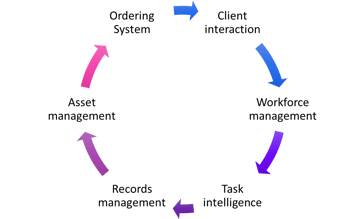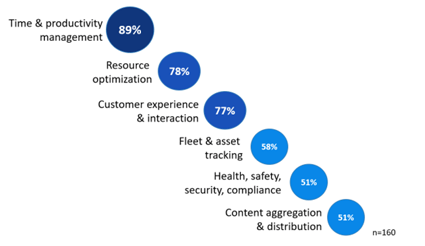
January 05, 2023 | 6 minute read
The future of enterprise digital automation
Omdia
Brian Washburn, Research Director, Service Provider Enterprise & Wholesale
The network connects, protects, and enables communication between devices and people. A well-designed enterprise network embeds security, reduces outages, consistently provides the performance levels its applications need, and is easy to scale and reconfigure. As enterprises add to their lists of digital projects, they will need a network that can support regular changes.
Ask top enterprise executives about their business priorities, and network is not usually their first answer. They are first worried about technologies that move businesses toward digital transformation, such as the shift to cloud, automation and analytics, the supply chain, partner and customer interactions, and workforce talent. Technology powers these business goals: cognitive processing, artificial intelligence, the Internet of Things, and autonomous operations.
Digital transformation to grow into automated chains
Most large enterprises are already on the road to digital transformation. They are in the early stages of digital adoption, automating pieces of their operations. What comes next? Companies will connect the digital pieces until there are longer activity chains inside and outside the business, including customers, suppliers, and partners. Figure 1 shows examples of digital platforms and applications that enterprises can mesh together in the future.
Figure 1: Examples of digital applications to be connected in the future


Source: Omdia
Below are two examples of how actual enterprise digital initiatives can evolve. One is in manufacturing, and the other in logistics and distribution.
Example 1: Manufacturing
- Today, a manufacturer adds cognitive processing to machines on the factory floor. The machines send visual data to an edge cloud for monitoring and quality control. They also send operating and performance data to the manufacturer’s cloud.
- In the future, the manufacturer will further connect machine output to troubleshooting and remediation systems. This includes inventory and dispatch. When a new machine goes out of spec, the system notifies the customer, orders the necessary replacement parts, tracks delivery, searches for a matching technician, and sets up a scheduled maintenance appointment. If a new machine experiences an operating failure, the alerts cascade through the supply chain. The system estimates the repair interval and assesses available inventory and the impact on the business. It feeds all the information to an operations executive who can map out a business response.
Example 2: Warehouse logistics
- Today, a distributor upgrades to an integrated warehouse system. Stored inventory uses RFID and 2D barcodes. The system tracks in real time the location and number of items in storage on site, and inventory can be checked for status and reordered as incoming orders are fulfilled.
- In the future, the distributor can connect the integrated warehouse system to its shipping system, which decides where to store items and how to route product orders to optimize delivery cost and efficiency. It collects information about energy efficiency that helps meet the company’s profitability and sustainability targets.
These digital applications, both today and in the future, rely heavily on networks. If connectivity fails, the business grinds to a halt. Digital applications are evolving, connecting, and becoming dependent on each other. Uptime, performance, security, and flexibility for sites and clouds will become even more critical.
Cognitive processing to fuel the next digital traffic boom
For an enterprise, network changes happen in cycles and waves. Add up all the changes, and net IP traffic consistently increases at nearly a 30% compound annual growth rate. This trend has held steady for more than a decade. Past growth came from boosts by wireless data and streaming video, and high-capacity, machine-to-machine communications are the next big growth engine.
Cognitive processing is a big-bandwidth, high-value digital application that fills many digital transformation roles. These platforms collect video streams, process video, analyze and interpret the results, respond with instructions, and store relevant data. It is a cornerstone of many solutions, including:
- Monitoring for production and quality control
- Compliance monitoring for workers
- Safety monitoring for transportation
- Security surveillance and facial recognition
- Inventory tracking and asset intelligence
- Records generated on remote conditions
Each of these applications relies on many simultaneous video streams. Whether those video streams are sent directly to the cloud or pre-processed locally, collectively, they present another big boom for traffic growth.
Figure 2 shows digital workloads that large enterprises have already adopted in—or are currently migrating to—public/hybrid cloud and SaaS applications. Sometimes this means a lift-and-shift from data center to cloud, but the digital transition has begun. The shift to cloud means uptime, consistent performance, security, and flexibility for the corporate network are critical.
Figure 2: Top digital workloads large enterprises have adopted on public/hybrid clouds and SaaS

Source: Omdia.
Network flexibility is just as important as uptime and security
Enterprises’ traffic patterns will change as they add and connect digital systems. Some network needs will be predictable (e.g., seasonal, quarterly, or monthly business cycles), and others will be unexpected (e.g., a spike in demand, a global supply disruption, or a customer or partner business change). Enterprises face one-time changes, for example, if a new system comes online that generates volumes of data.
Operations executives already have the costs of downtime and security breaches for enterprise networks burned into their minds. As they move up the digital value chain, executives will find there are also costs to inflexible partners and networks. Enterprises need a network partner that lets them change capacity and performance when and where they need it. A network-focused managed services provider can assist with consultation and project management, and it can adjust the network as enterprises’ needs change.
Conclusion
When top enterprise executives think about their business, they think about transforming operations and automating processes. But the network is just as critical. The network needs to be available and resilient, perform consistently, and be secure. Digital initiatives are connecting and evolving, and any network partner must embrace change. For this reason, larger multinational enterprises frequently choose network-focused managed services provider partners. This way, they get personalized attention and assurance that their partner will be flexible and help in adapting the network to changing business needs.
Share to
Omdia
Brian Washburn, Research Director, Service Provider Enterprise & Wholesale
Omdia is a leading research and advisory group focused on the technology industry. With clients operating in over 120 countries, Omdia provides market-critical data, analysis, advice and custom consulting.
More articles from OmdiaStay connected with Expereo
Be the first to hear about our latest insights, news, and updates.
